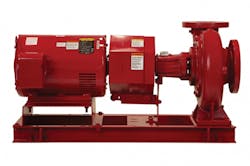Manufacturers navigate the road to compliance for clean-water pumps
This real-world example points to the impact that is expected when the Department of Energy (DOE) standards for pump efficiency go into effect in 2020, and an estimated 25 percent of the least efficient pumps are retired or redesigned to meet the new standards.
Since the Energy Conservation Standard for Pumps became effective this spring, manufacturers have been seeking guidance from the Hydraulic Institute (HI) and other industry leaders on the necessary steps for compliance by 2020. Even as some forward-thinking manufacturers have been introducing high-efficiency products to the marketplace in anticipation of the new rules (as in the example above), there are many questions about testing and certification procedures.
The DOE began the process to regulate clean-water rotodynamic pumps in 2011, with the goal of reducing the overall demand for energy in the United States. Leaders in the pump industry, through the HI, have been working shoulder to shoulder with the DOE to develop pump efficiency standards and test procedures. As such, the test procedures closely follow HI’s existing test methods contained in HI 40.6-2014, Methods for Rotodynamic Pump Efficiency Testing. However, there are some exceptions and additional requirements put forth by the DOE to ensure repeatable and reproducible test results, and to provide measurement methods and equipment specifications for the entire scope of pumps under the rule.
The standard targets five classes of pumps and includes detailed definitions and examples of each pump type, such as single stage, multistage, etc., along with parameters for characteristics such as horsepower, best efficiency point (BEP) rate of flow and BEP head, and temperature and speed.
Some of the terminology in the DOE standards deviates from HI definitions, so manufacturers must be sure they have a firm understanding of the DOE language, such as what qualifies as a basic model or a bare pump. Definitions don’t cover all pump models in all instances, so the DOE also has included a list of exceptions as well as further guidance on how to categorize a particular pump that doesn’t perfectly match the definition.
Metrics, testing
In the ruling, the DOE established a new metric called the Pump Energy Index (PEI) to rate the energy performance of pumps. Beginning on Jan. 27, 2020, all pumps distributed in commerce in the U.S. must have a PEI less than or equal to 1.00. The PEI is a ratio of the representative performance of the pump being rated over the representative performance of a pump that would minimally comply with any prospective DOE energy conservation standard for that pump type.
Minimally compliant pump efficiency is determined by a calculation that determines the Pump Energy Rating (PER), the weighted average of input power to the motor at defined duty points, and is the standard basis for all PEI ratings. The DOE’s rules on testing outline the steps to calculate PER in greater detail.
The ruling requires testing methods for both constant load and variable load equipment classes. A metric of PEI CL applies to pumps sold without variable speed controls; PEI VL applies to pumps sold with variable speed controls. DOE test procedures also contain methods to determine the appropriate index using either calculation based methods and/or testing based methods.
The guidelines include specific directions on testing procedures, following, in part, HI 40.6 guidelines. There are, however, differences between HI 40.6 and the DOE standard. For example, the DOE requires that at least two unique measurements be recorded more than 5 seconds apart, their mean computed, and that the two unique measurements are not farther away from the mean than the specified tolerance.
Also, during the actual testing, the pump must operate at expected BEP rate of flow for 20 minutes for warm-up and all measurement must be made under steady conditions, such as no vortexing or cavitation, and at a minimum of seven test points of expected BEP. If the actual BEP flow rate is off by more than 5 percent of the expected value, the test must be repeated.
The end game
Standards put in place by the DOE to achieve energy goals have spurred an even greater focus on efficiency by pump manufacturers. Technological advances are enabling designers to develop rapid prototypes of products such as pumps that offer better and longer lasting efficiencies.
This being true, energy-efficient components don’t work in silos. They need to work together as a complete system to achieve the highest efficiencies. In the case of the New York high-rise, the pumps are only one piece of the system design. Highly efficient suction diffusers and pressure independent control valves and integrated controls contributed to a 43 percent improvement in power consumption over the old system.
As the DOE and pump manufacturers work through the path to testing and certification, it is important not to lose sight of the greater gain that will be derived from improving the security and reliability of the nation’s energy system by reducing the overall demand for energy.
Mark Handzel is vice president, product regulatory affairs, and director, HVAC commercial buildings, Bell & Gossett, a Xylem Brand. He is a member of the U.S. Department of Energy Appliance Standards and Rulemaking Federal Advisory Committee’s Commercial and Industrial Pumps and Circulator Pumps Working Groups.

